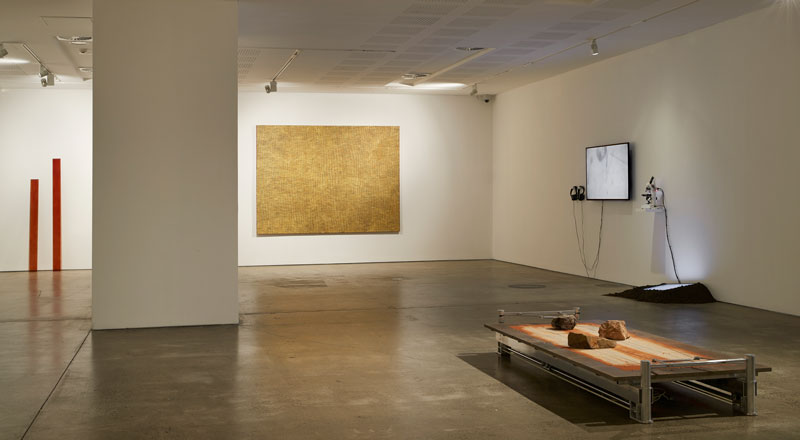
The sweep of the panorama is eschewed for probing the surface of country in the joint exhibitions of Rachel O’Reilly: The Gas Imaginary and Material Place: Reconsidering Australian Landscape. Curator Ellie Buttrose has exchanged the aerial focus of her previous foray into landscape, Limitless Horizon: Vertical Perspective (Queensland Gallery of Art and Gallery of Modern Art, Brisbane, 2017), for a set of geophysical and bioactive engagements based on the material properties of place—the associated matter of rocks, dirt, soil, biota, and so forth, that make up the crust of the Earth and the underlying strata. As explained in her catalogue essay, this exhibition “looks closely at the material properties used by artists to visualize Australian landscapes,” and, furthermore, seeks to ask: “what are the politics that frame these representations, and what do these frameworks express about our relationship with the environment?”
That said this is an unpredictable exhibition in which multiple contestations of economic, ecological, mineralogical, agricultural, cultural, political and ideological interests take unexpected turns. For example, reflections on soil biology challenge metaphysical fictions of the human in Tully Arnot’s Holobiont (2019), and Rachel O’Reilly’s Drawing Rights (2018) brings the unlikely coupling of eighteenth-century shipping practices and Torrens Title to bear on the legal foundation that limits the environmental responsibility of the corporations. Between them, these two works—Tully’s critique of Anthropocentrism and O’Reilly’s activist insights into mining rights—bookend the broad range of concerns expressed across both exhibitions.
Staked in the geological zone of the pedosphere, the layer on the Earth’s crust that is the foundation of terrestrial life, Arnot’s multimedia installation, Holobiont immerses the viewer in reactions of biogeochemical flux and the processes of soil formation. On the video screen, the hand of Tully’s narrator is viewed in the dirt, letting his fingers run through rich dark humus. The role accorded the voiceover signals that this is essentially a conversational work. As he lightly sifts the soil, feeling the elements of its consistency, he reflects out loud on the phenomenon of geophagia, the human desire to eat soil.
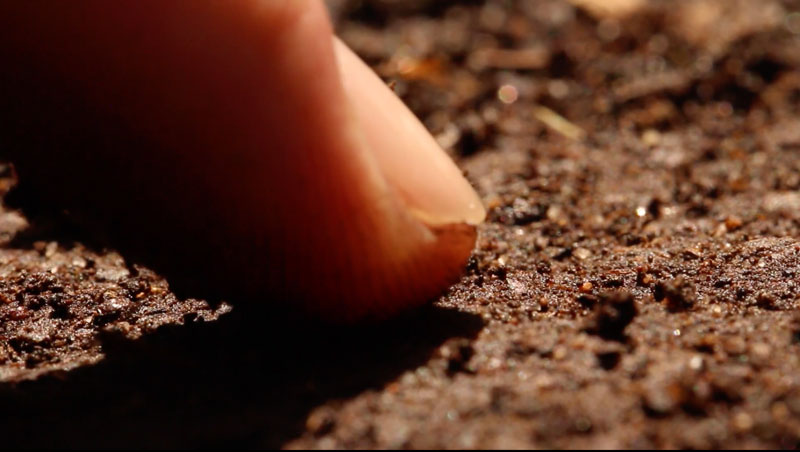
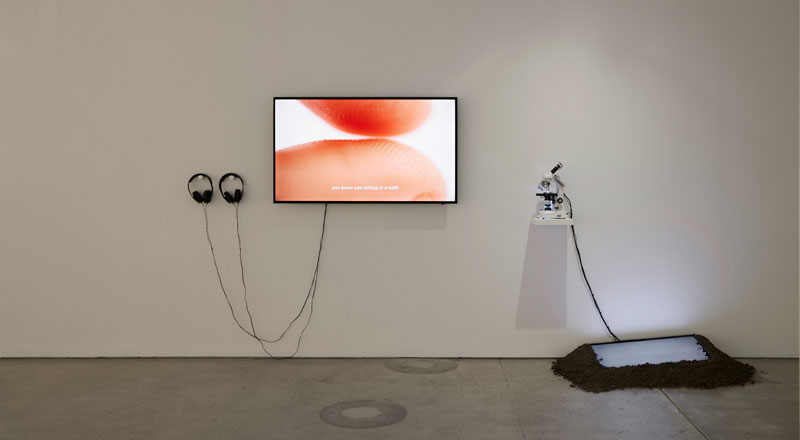
Tully notes that this tendency is most prevalent in pregnant women, and that small children often develop a taste for ingesting mud. Among further reveals we learn that the attractive scent of soil after rain—an effect of the decomposition of bacteria—is an aroma called geosmin that the human nose can detect in concentrations as low as five parts per trillion. Evidently our affinity for soil, and its load of bacteria, is stored deep in our ancient DNA. Perhaps the most startling fact, cited from Timothy Moreton’s Humankind, is that only two thirds of mother’s milk is digestible, with the remainder specifically evolved for nourishment of the bacteria inhabiting the baby’s gut.
Over the course of what is overheard, Arnot builds towards proof that the human is indivisibly merged with the bacterial biome, and therefore is part of a holobiont—the scientific name for assemblages of different species that form ecological units. First postulated in cell research in 1967 by Lyn Margulis, the eminent American microbiologist, scientist and “earth mother”, the term now enjoying broad application, especially after bio-molecular research was embraced by the radical philosophers of the 1980s. In A Thousand Plateaus (1980) Deleuze and Guattari challenge the eighteenth-century taxonomy of Linnaeus, which along with earlier taxonomies of the ancient Greeks ranks the human as the dominant life form.
Arguing for the decentering of the human from the place of privilege in the scheme of beings, their theory of ethology (the “science of behaviours”) is based on non-hierarchical interspecies assemblages. Indeed, as Arnot’s narration makes clear, what attracts his interest are the repercussions of this research, on the one hand bringing humans into closer connectedness with the Earth, but also philosophically challenging and debunking older metaphysical and theological notions of the isolatable pure human.
Rachel O’Reilly’s Drawing Rights defends affinities with the soil and its fertile biota from the very different macro perspective of environmental rights and legislation for the land. Rather than science-based her discoveries are of the legal kind, specifically on the implementation of Torrens Title—developed by Scotsman Robert Torrens, in 1880, to keep track of cargo—in the management of titles to land. As such O’Reilly addresses a certain madness of equivalence between shipped property and land, tracing how a change in the system of land title would have disastrous consequences for the environment, rendering land protection from the extraction industries, principally gas fracking in her native Gladstone, Queensland, near impossible.
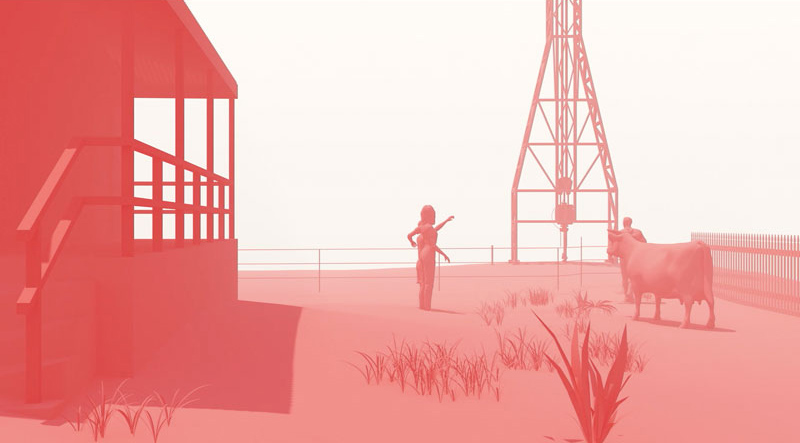
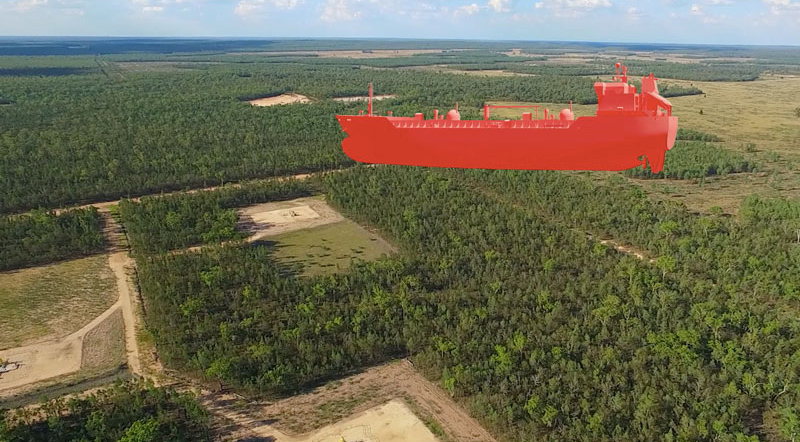
Like Arnot, O’Reilly brings a spare and poetic touch to screen-based narrative. The video medium can be a tricky form when your content falls out of the usual modes of the genre. In Holobiont Arnot was literally fingering soil in close up in order to develop a form of affective relationship with the viewer for microscopic biota. O’Reilly has a similarly difficult task with the dry subject of legislation, and like Arnot relies on the persuasiveness of her intonation and the clarity of a pared-down text to accompany her visualisations.
Drawing Rights is, in fact, visually divided into two parts, the first of which is represented as a stripped back video game, in monochrome, in which the protagonists, a farming family, stare over the edge of a mining void where the pixels have run out. This is the “dry section” where we learn about Torrens Title and its difference from Old Title in which all changes in land use or occupation, development of buildings and so forth, were dutifully recorded and checked by lawyers with every change of ownership. Such details of land use would be taken into account in any future development: in short, land had a history independent of the transience of its owners and under Old Title carried over ethical concerns and responsibilities. All this changed with the introduction of the Torrens system that, in effect, was no more than a tracking device attaching a parcel of anything—land, a crate of whisky—to a person. Any history of land use was erased.
In terms of environmental protections, Torrens Title is a disaster. On the one hand, the loss of history leads to the dematerialisation of the relationship to the land, which is regarded as a tabula rasa for the new owners to deal with as they wish. With evident parallels O’Reilly draws attention to the doctrine of Terra Nullius that, like Torrens Title, was a doctrine of erasure. One of the scandals of Terra Nullius was its retrospective application, some fifty years after the 1788 British invasion, in express defiance of the Letters Patent issued by King William IV in 1836 which decreed too late—long after the ravages of colonisation—that nothing should obstruct the Aboriginals in the possession and enjoyment of their land. As with Native Title cases, one of the most onerous aspects of Torrens Title is that, in cases where farmers or traditional owners are objecting to mining proposals, the onus is on the objector to credibly prove former use. In other words, the objector is obliged to recreate the history that was once legally encoded under Old Title and hence protected under law.
The second phase of Drawing Rights swaps the computer-generated figures for drone footage of the actual gas fields of Gladstone, where toxic pollution is evident in the unnatural hues of the containment pools turned odd aqua blues. As the camera passes over ruined country, we’re told that the presence of salt and toxins “turns off” life in the topsoil.
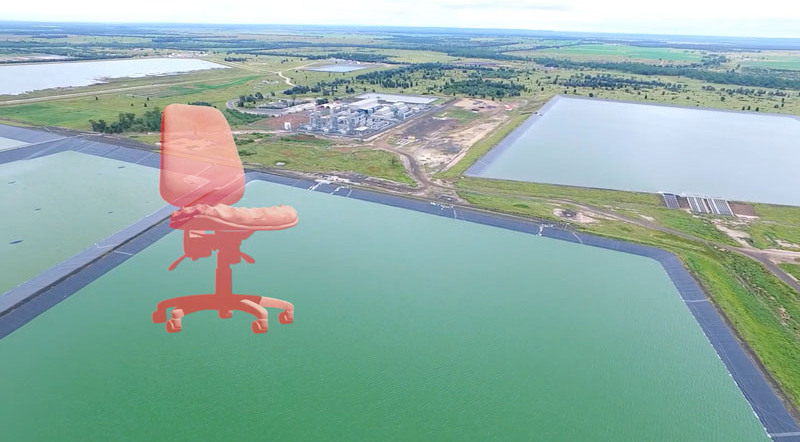
This shared concern with the precious bioactivity of the soil layer links O’Reilly’s Drawing Rights with Arnot’s Holobiont as mutually extended chapters of the same story. Arnot lets the viewer know in no uncertain terms of the importance of maintaining a healthily active pedosphere—in the extreme, human health is dependent on bacterial health—while Drawing Rights delivers the disconnection of a legal system so abstracted as to put this fragile ecological relationship at risk, over and over again throughout the many countries of the world where Torrens Title is now the norm. Exhibited together Holobiont and Drawing Rights make for successful companion works.
With a certain insistence, the recurring theme of the “geology of morals” (Deleuze and Guattari) drives a further cluster of works, including Touching Pindan (2016) by Yarawu artist Robert Andrew. Drawing on the political license of his indigenous heritage, Andrew incorporates samples of the sandy clay of pindan from his father’s Country in an installation in which a mechanised apparatus is grinding the soft pindan to dust. Given the operational scale of the region’s Big Mining, systematically razing mountains of iron-bearing ore, Andrew’s “destruction-apparatus” resonates strongly with the actions of the 1960s Destruction in Art environmentalists. Though less extreme than Wolf Vostell’s orchestration of the collision of a train into a car (NEUN NEIN DÈ-COLL/AGEN, 1963), or Gustav Metzger’s subjection of nylon sheets to corrosive jets of hydrochloric acid (Acid Action Painting, 1961), Andrew’s apparatus nonetheless channels an action of regulated violence to political and artistic effect.
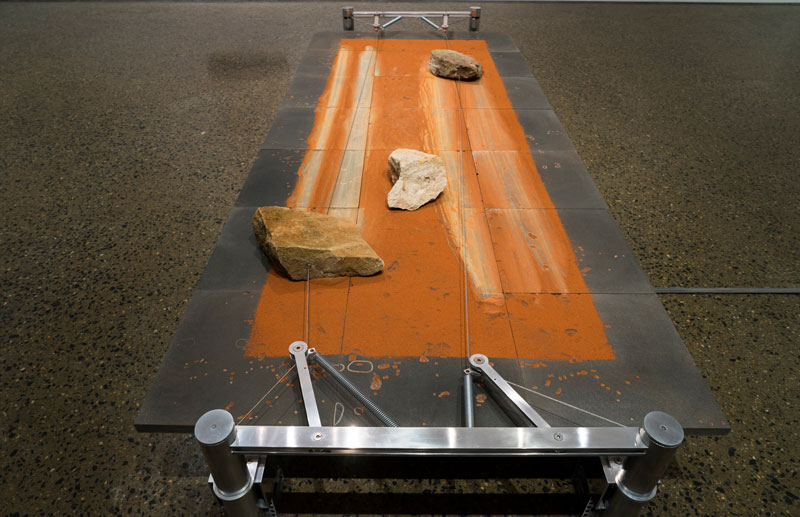
Likewise, Brodie Ellis deploys the Destruction in Art aesthetic in The Crystal World (2016), a video engagement with the ironically named practice of “green fields” mining. Stitching together found footage of mining blasts across numerous different locations, Ellis exposes the explosion of vast swathes of country as ridge after ridge is blown up. Bonita Ely’s less overtly destructive Controlled Atmosphere Inc.: Lake PeddXer Environmental lmpact Statement & Progressive Dementia of Integrated Resource Assembly (1983) nevertheless tracks the failed bureaucratic management of Lake Pedder through the abstract representations of old print-outs and Roneographs, while in a similar vein Lu Forsberg’s two-channel installation Downstream (Mount Morgan and Mount Oxide) (2018) contrasts the photographic capture of “land as it is” in Google earth flyovers with the abstract geometries of Land Title.
Far away in Yolgnu country, in a gesture of cultural reassertion, Gunybi Ganambarr has been incising sacred designs from barks and memorial poles onto the discarded rubber conveyor belts left strewn around Country by the miners. In its industrial scale the litter is an insult to the traditional owners. As indigenous actor David Gulpilil remarked in the recent documentary, Another Country, this rubbish is the white man’s legacy—Yolgnu artifacts, by contrast, decomposed back into the cycles of nature. In a David versus Goliath action, reflective of the miners’ larger say over what happens on country, Ganambarr’s response has been to score Yolgnu marks deeply into the rubber in the making of Ngalkan. In this way, Ngalkan also becomes an act of repatriation of waste from traditional lands.
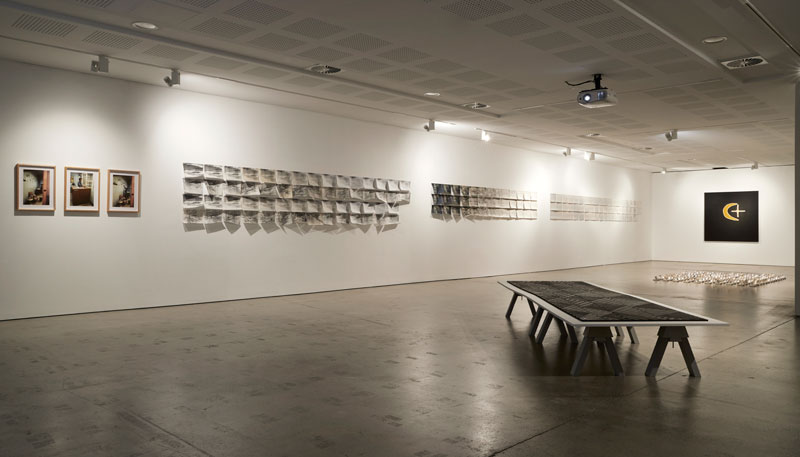
In sum, with strong representation of Indigenous artists lending their authority to considerations of country Material Place is an exhibition rich in complexity and multiple perspectives of correspondence and counterpoint. The paintings by Mabel Juli, Garnkiny Ngarrangkarni (Moon Dreaming), and Yukultji Napangati, Untitled (2011), lend synergies of natural rapport to Nicholas Mangan’s Termite Economies (2018), an exploration of the ecological efficiencies of Nature’s non-human agents. On the historical front, Foundations II (2016) by Quandamooka artist Megan Cope lays out a grid of oyster shells, upright in cement, to recall the burning of the middens in the manufacturing of lime for colonial mortar, and in a work titled The Boys (2018), Dale Harding applies extracts of Xanthorrhoea resin to two long planks casually leaning against the wall, to remind that in former, more openly racist times, Xanthorrhoea trees were nicknamed Black Boys. From an unlikely premise suggestive of a narrow, geological scope this exhibition is revelatory in the scope of its ideas.
.jpg)












